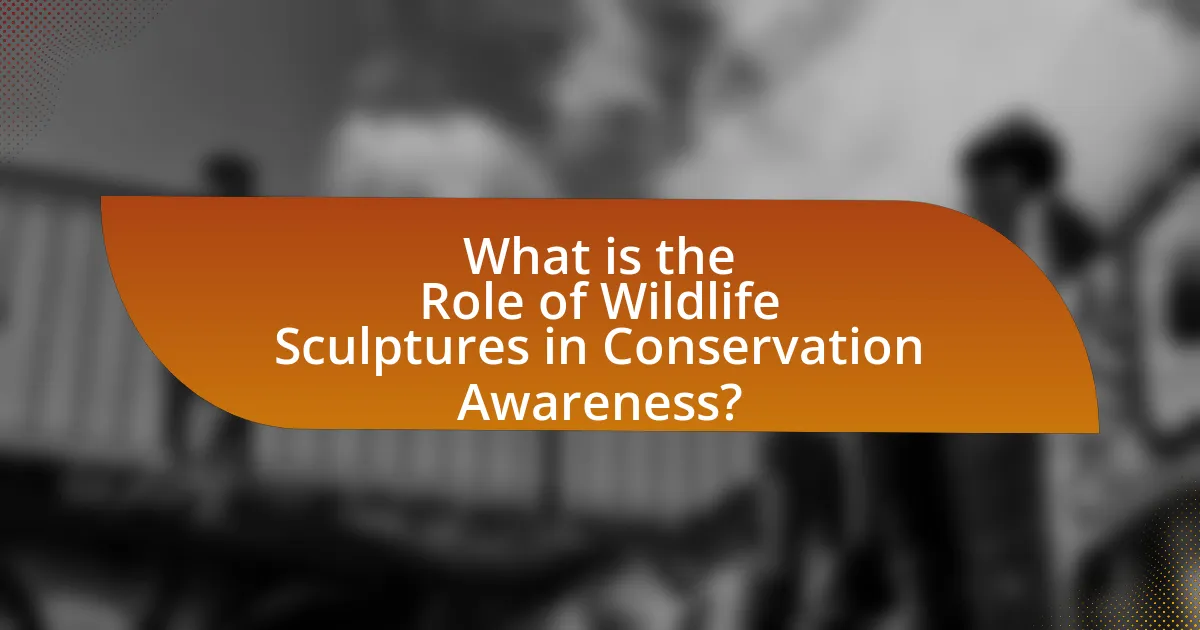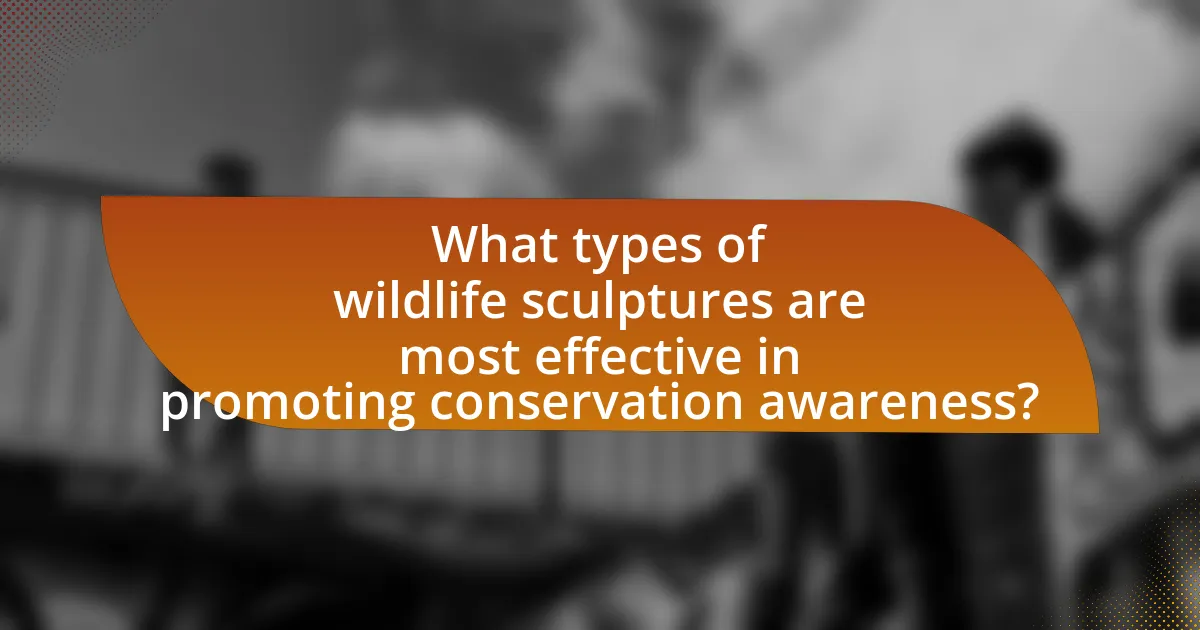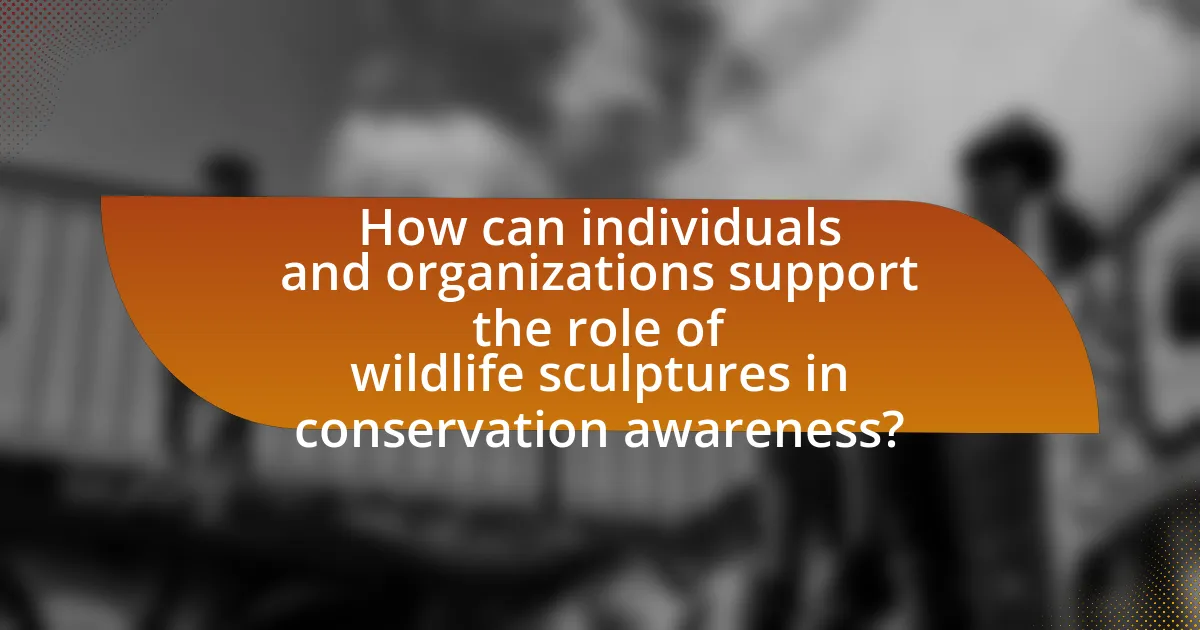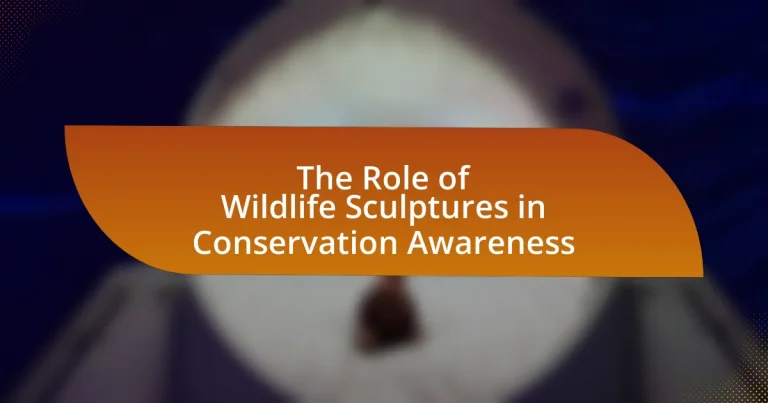Wildlife sculptures serve a crucial role in raising conservation awareness by visually representing endangered species and their habitats, fostering emotional connections, and promoting public engagement. These artistic representations not only educate the public about biodiversity loss and conservation efforts but also stimulate discussions and advocacy for wildlife protection. The article explores how wildlife sculptures contribute to conservation initiatives, convey important messages about environmental issues, and enhance learning experiences, while also examining the challenges artists face in creating impactful works. Additionally, it highlights effective strategies for integrating wildlife sculptures into community conservation efforts and the best practices for maximizing their influence on public perception and action regarding endangered species.

What is the Role of Wildlife Sculptures in Conservation Awareness?
Wildlife sculptures play a significant role in conservation awareness by visually representing endangered species and their habitats, thereby fostering emotional connections and promoting public engagement. These artistic representations serve as powerful tools for education, as they can convey messages about biodiversity loss and the importance of conservation efforts. For instance, exhibitions featuring wildlife sculptures often attract attention and encourage discussions about environmental issues, leading to increased awareness and advocacy for wildlife protection. Studies have shown that art can influence public perception and inspire action, making wildlife sculptures an effective medium for raising awareness about conservation challenges.
How do wildlife sculptures contribute to conservation efforts?
Wildlife sculptures contribute to conservation efforts by raising awareness and fostering appreciation for biodiversity. These artistic representations often depict endangered species, prompting viewers to engage with conservation issues. For instance, public installations of wildlife sculptures can attract attention and stimulate discussions about habitat preservation and species protection. Additionally, proceeds from the sale of wildlife sculptures frequently support conservation organizations, directly funding initiatives aimed at protecting wildlife and their habitats. This dual role of education and financial support underscores the significant impact that wildlife sculptures have on conservation efforts.
What messages do wildlife sculptures convey about conservation?
Wildlife sculptures convey messages about conservation by highlighting the beauty and fragility of nature, urging viewers to appreciate and protect wildlife. These artistic representations often depict endangered species, serving as a visual reminder of the threats they face, such as habitat loss and climate change. For instance, a sculpture of a polar bear can evoke empathy and raise awareness about the impacts of global warming on Arctic habitats. By engaging the public emotionally, wildlife sculptures foster a sense of responsibility and inspire action towards conservation efforts, reinforcing the idea that preserving biodiversity is essential for ecological balance and human well-being.
How do these sculptures engage the public in conservation issues?
Wildlife sculptures engage the public in conservation issues by serving as visual and emotional catalysts that raise awareness about environmental challenges. These sculptures often depict endangered species or habitats, prompting viewers to reflect on the impact of human activities on biodiversity. For example, installations in public spaces can attract attention and spark conversations about conservation efforts, leading to increased community involvement and support for wildlife protection initiatives. Studies have shown that art can effectively communicate complex environmental messages, making the sculptures a powerful tool for fostering a deeper understanding of conservation issues among diverse audiences.
Why are wildlife sculptures important for environmental education?
Wildlife sculptures are important for environmental education because they serve as powerful visual tools that raise awareness about biodiversity and conservation issues. These sculptures engage the public emotionally and intellectually, prompting discussions about wildlife habitats and the impact of human activities on ecosystems. Research indicates that art can enhance learning experiences; for instance, a study published in the Journal of Environmental Education found that art installations significantly increased participants’ understanding of environmental concepts. By depicting animals in their natural forms, wildlife sculptures foster a connection between viewers and the natural world, ultimately encouraging stewardship and responsible environmental behavior.
What educational themes are often represented in wildlife sculptures?
Wildlife sculptures often represent educational themes such as biodiversity, habitat preservation, and the interconnectedness of ecosystems. These themes aim to raise awareness about the importance of wildlife conservation and the impact of human activities on natural habitats. For instance, sculptures depicting endangered species serve to highlight the urgency of protecting these animals and their environments, thereby fostering a deeper understanding of ecological balance and conservation efforts.
How do sculptures enhance learning experiences about wildlife conservation?
Sculptures enhance learning experiences about wildlife conservation by providing tangible representations of animals, which can evoke emotional connections and foster engagement. These three-dimensional artworks serve as visual aids that can illustrate the beauty and diversity of wildlife, making the subject matter more relatable and impactful for viewers. Research indicates that visual stimuli, such as sculptures, can significantly improve retention of information; for instance, a study published in the Journal of Environmental Education found that participants exposed to visual representations of wildlife demonstrated a 30% increase in knowledge retention compared to those who only received textual information. This suggests that sculptures not only attract attention but also facilitate deeper understanding and appreciation of conservation issues.
In what ways do wildlife sculptures influence public perception of endangered species?
Wildlife sculptures influence public perception of endangered species by evoking emotional responses and raising awareness about conservation issues. These artistic representations often highlight the beauty and fragility of endangered animals, prompting viewers to connect with the species on a personal level. For instance, studies have shown that visual art can significantly impact attitudes toward wildlife, as seen in exhibitions that feature sculptures of endangered species, which have led to increased public interest and support for conservation initiatives. Additionally, wildlife sculptures serve as educational tools, providing information about the species’ habitats, behaviors, and threats, thereby fostering a deeper understanding of the challenges they face. This combination of emotional engagement and education effectively shifts public perception, encouraging advocacy and action for the protection of endangered species.
How do artistic representations affect emotional responses to wildlife conservation?
Artistic representations significantly enhance emotional responses to wildlife conservation by evoking empathy and raising awareness about endangered species. These representations, such as sculptures and paintings, create a visceral connection between the viewer and the subject, often highlighting the beauty and fragility of wildlife. Research indicates that visual art can trigger emotional engagement, leading to increased motivation for conservation efforts. For instance, a study published in the journal “Conservation Biology” by researchers at the University of Kent found that participants exposed to artistic depictions of wildlife reported higher levels of concern for conservation issues compared to those who viewed factual information alone. This demonstrates that artistic representations can effectively influence public sentiment and drive action towards wildlife conservation.
What role do sculptures play in raising awareness about specific species?
Sculptures play a significant role in raising awareness about specific species by visually representing them and evoking emotional responses from viewers. These artistic representations can highlight the beauty and uniqueness of endangered or threatened species, making the public more aware of their plight. For instance, large-scale sculptures of animals, such as the life-sized elephant sculpture in the “Elephant Parade,” have been used to draw attention to the issues of poaching and habitat loss, effectively engaging audiences in conservation efforts. Studies have shown that visual art can enhance public understanding and empathy towards wildlife, leading to increased support for conservation initiatives.
How can wildlife sculptures be used in community conservation initiatives?
Wildlife sculptures can be utilized in community conservation initiatives by serving as educational tools that raise awareness about local biodiversity and environmental issues. These sculptures can be strategically placed in public spaces, such as parks and community centers, to engage the public and stimulate discussions about wildlife conservation. For instance, a study by the World Wildlife Fund found that art installations, including sculptures, can increase community involvement in conservation efforts by up to 40%, as they create a visual and emotional connection to the subject matter. Additionally, workshops and events centered around creating wildlife sculptures can foster community participation and collaboration, further enhancing conservation efforts.
What are the challenges faced in creating impactful wildlife sculptures?
Creating impactful wildlife sculptures involves several challenges, including accurately representing the species, capturing their essence, and conveying a message about conservation. Artists must conduct extensive research to ensure anatomical correctness and behavioral authenticity, which can be time-consuming and requires a deep understanding of the wildlife being depicted. Additionally, the choice of materials and techniques can affect the sculpture’s durability and visual impact, necessitating a balance between artistic expression and practical considerations. Furthermore, the ability to evoke emotional responses from viewers is crucial; this requires skill in design and execution to create a connection between the artwork and the audience. These challenges highlight the complexity of wildlife sculpture as a medium for raising conservation awareness.

What types of wildlife sculptures are most effective in promoting conservation awareness?
Realistic and life-sized wildlife sculptures are most effective in promoting conservation awareness. These sculptures engage viewers by accurately representing the animals and their habitats, fostering a deeper emotional connection. Studies show that realistic depictions can evoke empathy and inspire action; for instance, a survey conducted by the National Wildlife Federation found that 70% of participants felt more inclined to support conservation efforts after viewing lifelike animal representations. Additionally, interactive sculptures that allow for viewer participation can enhance awareness and understanding of conservation issues, as they create memorable experiences that resonate with the audience.
How do different materials and styles affect the impact of wildlife sculptures?
Different materials and styles significantly influence the impact of wildlife sculptures by affecting their aesthetic appeal, durability, and emotional resonance with viewers. For instance, bronze sculptures often convey a sense of permanence and strength, which can evoke a deeper appreciation for wildlife conservation, as seen in the works of artists like Edward Kemeys, whose bronze pieces have become iconic representations of American wildlife. In contrast, sculptures made from recycled materials can highlight environmental issues and promote sustainability, as demonstrated by the works of artists like Angela Haseltine Pozzi, who uses ocean debris to create impactful pieces that raise awareness about marine conservation. Additionally, the style of the sculpture, whether realistic or abstract, can alter viewer engagement; realistic depictions may foster empathy and connection, while abstract forms can provoke thought and discussion about the essence of wildlife. Thus, the choice of materials and artistic styles plays a crucial role in enhancing the effectiveness of wildlife sculptures in promoting conservation awareness.
What are the most common materials used in wildlife sculptures?
The most common materials used in wildlife sculptures include bronze, stone, wood, and clay. Bronze is favored for its durability and ability to capture fine details, making it a popular choice among sculptors. Stone, such as marble or granite, is often used for its permanence and natural beauty, while wood provides a warm, organic feel that can highlight the intricacies of animal forms. Clay is frequently utilized for its malleability, allowing for detailed and expressive representations. These materials are widely recognized in the art community for their unique properties that enhance the artistic expression of wildlife themes.
How does the style of a sculpture influence its message about conservation?
The style of a sculpture significantly influences its message about conservation by shaping the viewer’s emotional response and engagement with the subject matter. For instance, realistic sculptures that depict endangered species in their natural habitats can evoke empathy and a sense of urgency, prompting viewers to consider the impact of human actions on wildlife. In contrast, abstract sculptures may provoke thought and discussion about conservation in a more conceptual manner, encouraging viewers to interpret the message in diverse ways. Research indicates that emotional engagement is crucial for effective conservation messaging; sculptures that resonate emotionally can lead to increased awareness and action towards conservation efforts.
What are some notable examples of wildlife sculptures that have raised conservation awareness?
Notable examples of wildlife sculptures that have raised conservation awareness include the “Endangered Species” series by artist David Rogers, which features large-scale sculptures made from natural materials and highlights various endangered species. Another significant example is the “Wildlife Conservation Sculpture” by artist John Lopez, which uses scrap metal to create lifelike representations of animals, drawing attention to habitat loss and the importance of conservation efforts. Additionally, the “Elephant Parade” showcases hand-painted elephant sculptures created by various artists worldwide, promoting awareness for elephant conservation and raising funds for related charities. These sculptures serve as powerful visual tools that engage the public and foster discussions about wildlife preservation.
Which artists are known for their contributions to wildlife sculpture and conservation?
Artists known for their contributions to wildlife sculpture and conservation include Robert Bateman, who is renowned for his realistic depictions of wildlife and advocacy for environmental preservation. Another significant figure is Carl Rungius, recognized for his detailed representations of North American wildlife and his efforts in promoting conservation through art. Additionally, the work of Andy Goldsworthy, who creates site-specific sculptures using natural materials, emphasizes the relationship between art and nature, raising awareness about environmental issues. These artists have not only created impactful sculptures but have also actively participated in conservation initiatives, demonstrating the powerful role of art in promoting wildlife conservation.
What specific campaigns have successfully utilized wildlife sculptures?
Specific campaigns that have successfully utilized wildlife sculptures include the “Wildlife Conservation Sculpture Project” in South Africa, which featured life-sized sculptures of endangered species to raise awareness about poaching. Another example is the “Sculpture by the Sea” exhibition in Australia, where artists create large-scale sculptures along coastal walkways, often highlighting marine life and environmental issues. These campaigns effectively engage the public and promote conservation messages through visual art, drawing attention to the plight of wildlife and the importance of protecting their habitats.

How can individuals and organizations support the role of wildlife sculptures in conservation awareness?
Individuals and organizations can support the role of wildlife sculptures in conservation awareness by funding and promoting public art installations that depict endangered species. These sculptures serve as visual reminders of the need for conservation, attracting attention and sparking conversations about wildlife protection. For instance, studies have shown that public art can increase community engagement and awareness, leading to greater support for conservation initiatives. Additionally, hosting educational events or workshops around these sculptures can further enhance their impact, providing audiences with information on local wildlife and conservation efforts.
What actions can individuals take to promote wildlife sculptures in their communities?
Individuals can promote wildlife sculptures in their communities by organizing public art exhibitions that feature these sculptures. Such exhibitions can raise awareness about wildlife conservation and engage the community in discussions about environmental issues. Additionally, individuals can collaborate with local artists to create wildlife sculptures that reflect the region’s biodiversity, thereby fostering a sense of local pride and connection to nature. Hosting workshops or educational programs about the importance of wildlife and the role of art in conservation can further enhance community involvement. According to a study published in the Journal of Environmental Psychology, public art can significantly increase community engagement and awareness regarding environmental issues, demonstrating the effectiveness of these actions.
How can schools incorporate wildlife sculptures into their curriculum?
Schools can incorporate wildlife sculptures into their curriculum by integrating art projects that focus on local wildlife and environmental themes. This approach allows students to engage in hands-on learning while fostering an appreciation for biodiversity. For instance, art classes can include lessons on sculpting techniques using sustainable materials, encouraging students to create representations of endangered species. Additionally, interdisciplinary projects can be developed, combining science and art, where students research specific animals and their habitats, then create sculptures that reflect their findings. This method not only enhances artistic skills but also raises awareness about conservation issues, as evidenced by studies showing that art can effectively communicate environmental messages and inspire action among youth.
What are some ways to collaborate with local artists for conservation projects?
Collaborating with local artists for conservation projects can be achieved through several effective methods. One approach is to organize community art events where artists create wildlife sculptures that raise awareness about specific conservation issues, such as endangered species or habitat loss. These events can attract public attention and foster community engagement, as seen in initiatives like the “Wildlife Sculpture Trail” in various cities, which showcases local artists’ work while promoting conservation messages.
Another method is to partner with artists to develop educational programs in schools, where students can learn about wildlife and conservation through hands-on sculpture workshops. Research indicates that integrating art into education enhances students’ understanding of environmental issues, making this a valuable collaboration.
Additionally, local artists can be commissioned to create public art installations that highlight conservation themes, which can serve as focal points for community discussions and activism. For instance, the “Ocean Heroes” project in California involved artists creating large-scale sculptures from ocean debris, effectively raising awareness about marine pollution.
These collaborations not only support local artists but also amplify conservation efforts by engaging the community in meaningful dialogue about environmental stewardship.
What best practices should be followed when creating wildlife sculptures for conservation awareness?
When creating wildlife sculptures for conservation awareness, artists should prioritize using sustainable materials to minimize environmental impact. Sustainable materials, such as recycled metals or biodegradable substances, not only reduce waste but also convey a message of ecological responsibility. Additionally, artists should engage with local conservation organizations to ensure that the sculptures accurately represent the species and habitats they aim to protect, fostering authenticity and educational value. Collaborating with experts can enhance the sculptures’ impact by incorporating scientific facts about the species’ conservation status, which can be displayed alongside the artwork. Furthermore, positioning sculptures in high-traffic public areas increases visibility and encourages community engagement, making the art a catalyst for discussion about wildlife conservation.
How can wildlife sculptures be effectively integrated into conservation campaigns?
Wildlife sculptures can be effectively integrated into conservation campaigns by using them as focal points for public engagement and education. These sculptures can serve as visual representations of endangered species, drawing attention to their plight and the importance of conservation efforts. For instance, large-scale installations in public spaces can attract foot traffic and encourage discussions about wildlife preservation, thereby raising awareness.
Moreover, incorporating interactive elements, such as augmented reality features that provide information about the species depicted, can enhance the educational aspect of the sculptures. Research shows that visual art can significantly impact public perception and behavior regarding environmental issues, making sculptures a powerful tool in conservation messaging. By strategically placing these artworks in high-visibility areas and linking them to specific conservation initiatives, campaigns can effectively mobilize community support and action.

